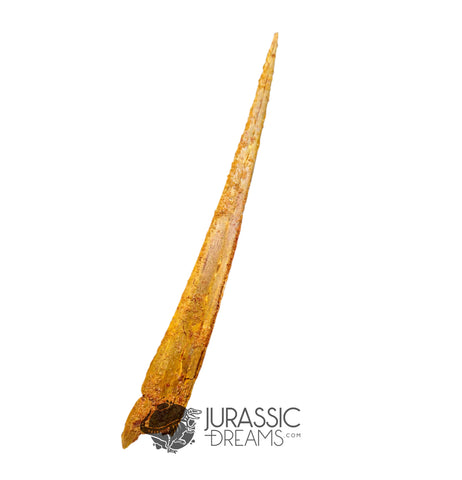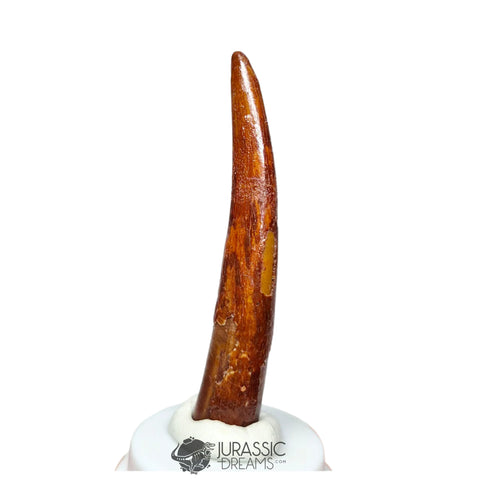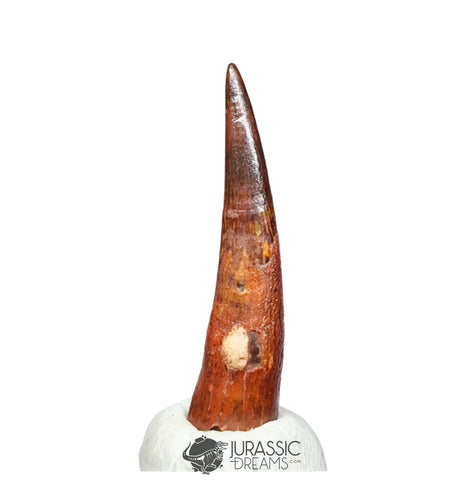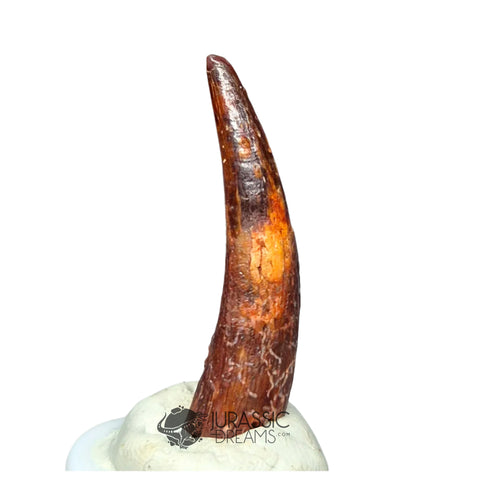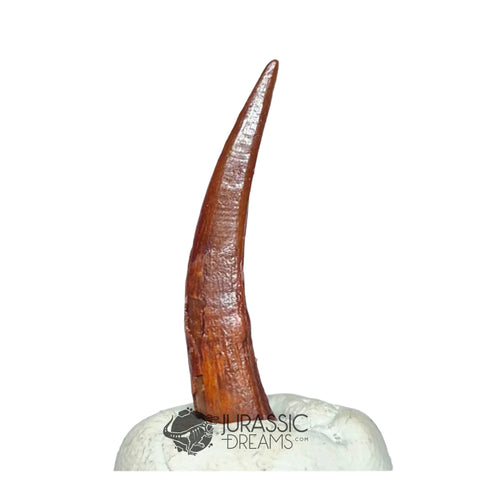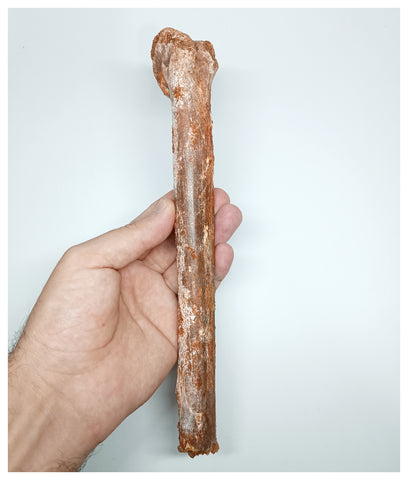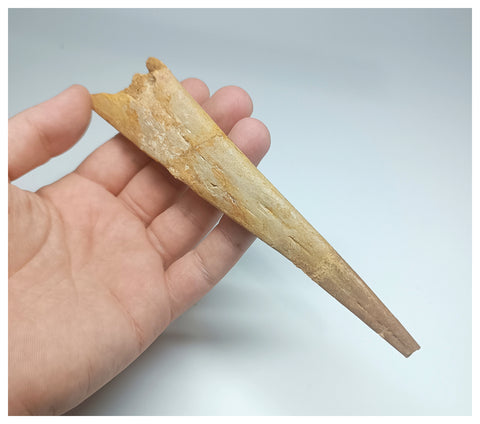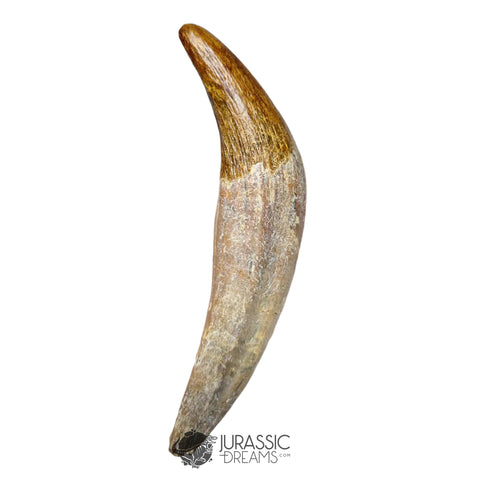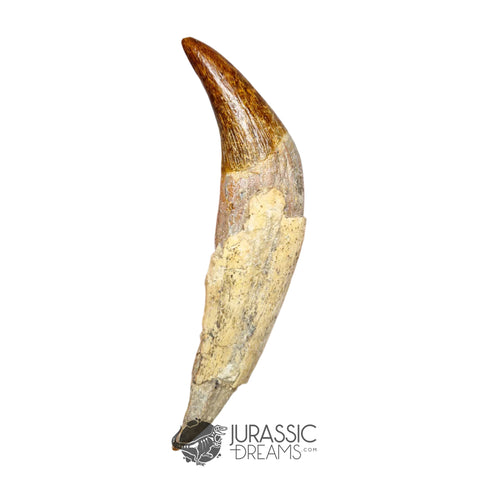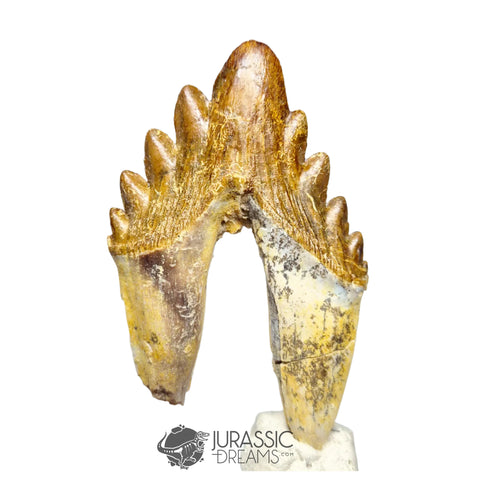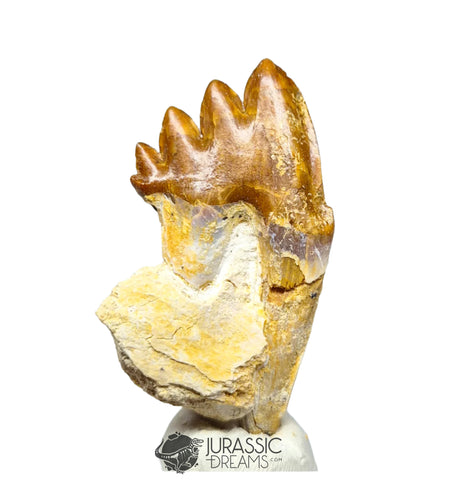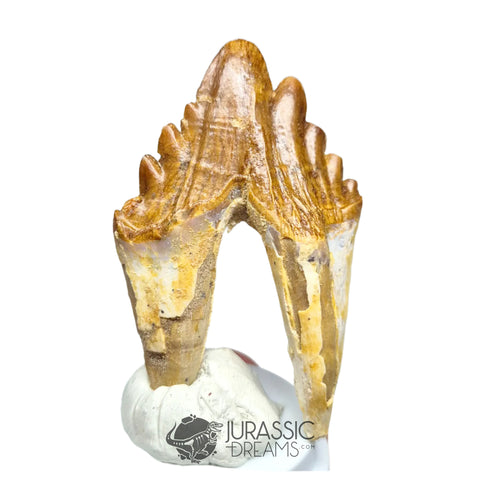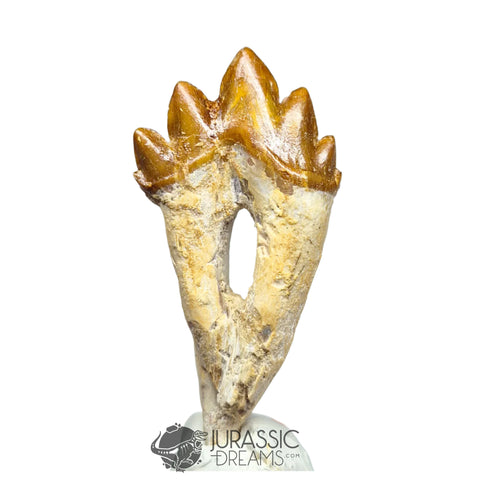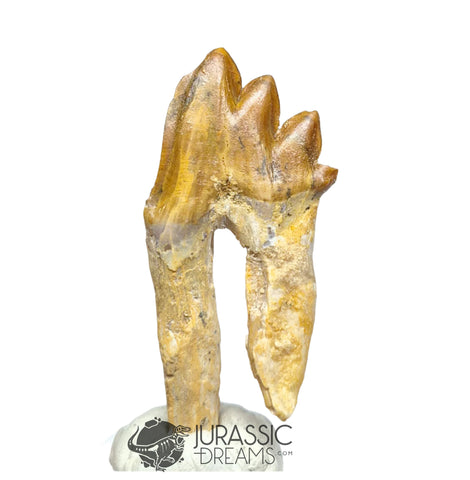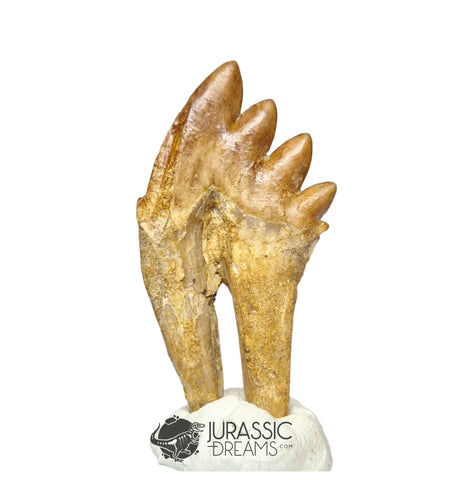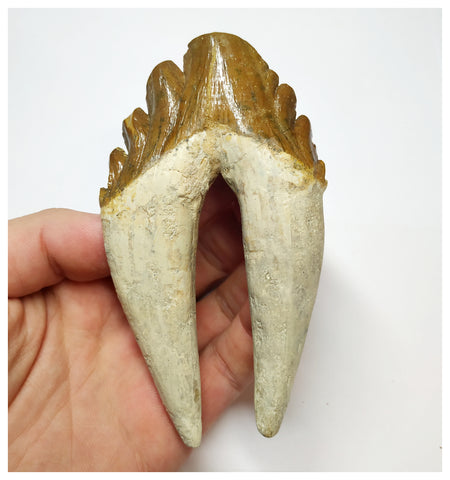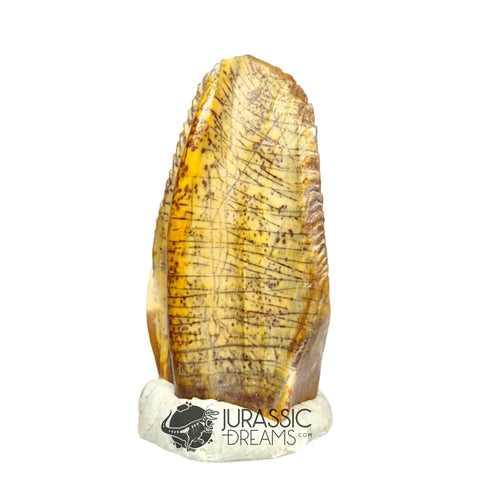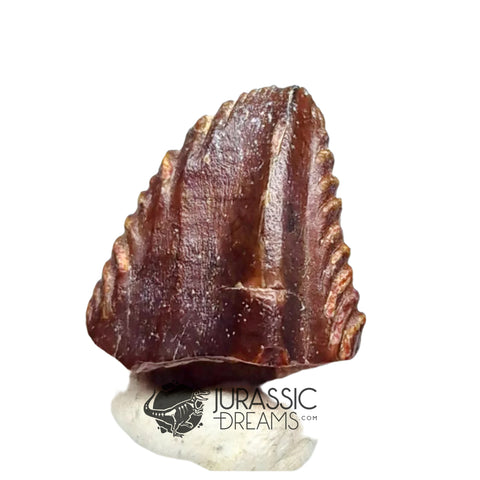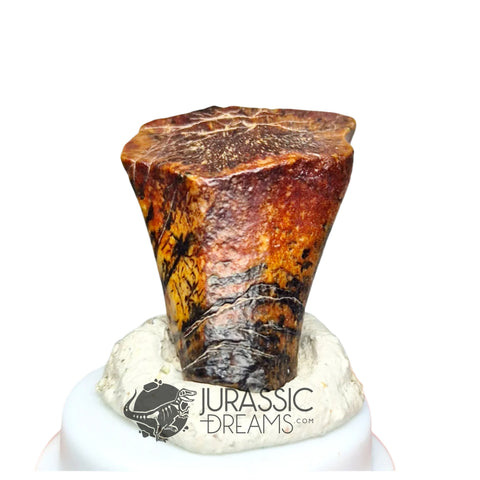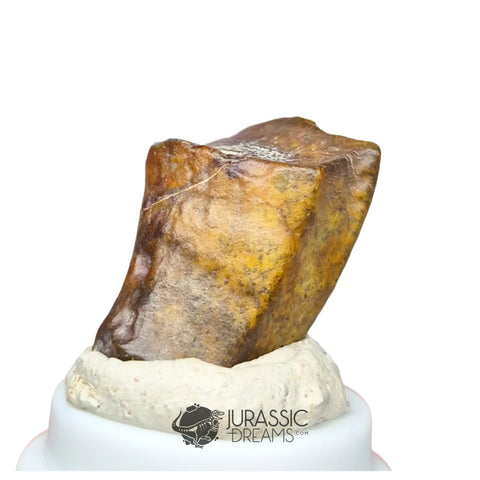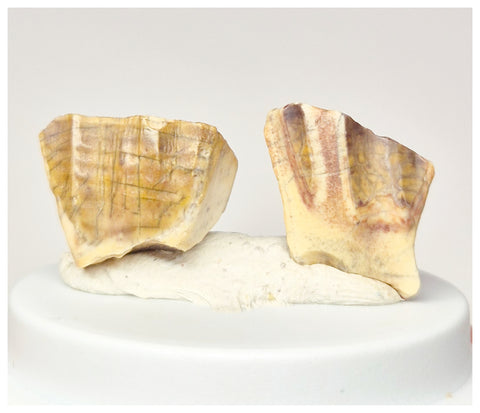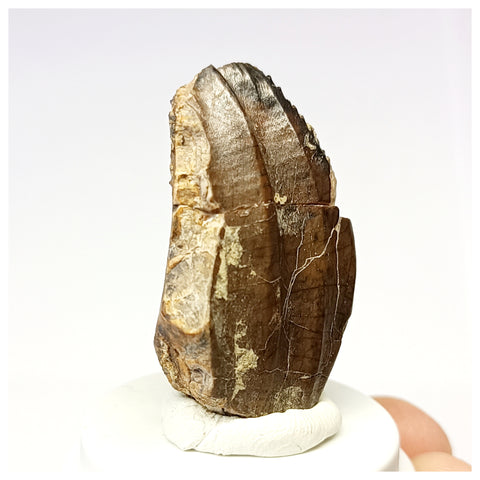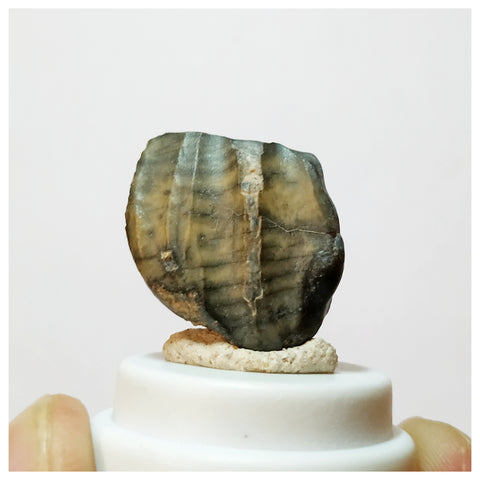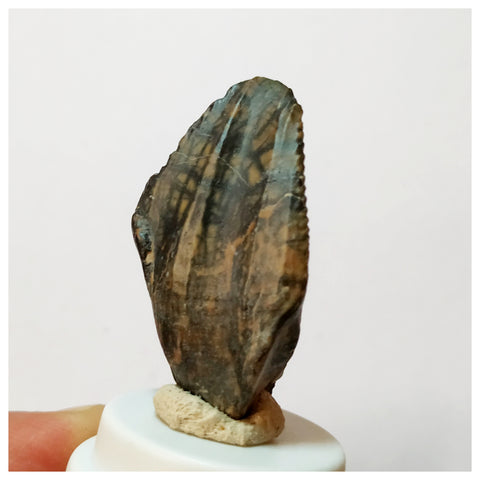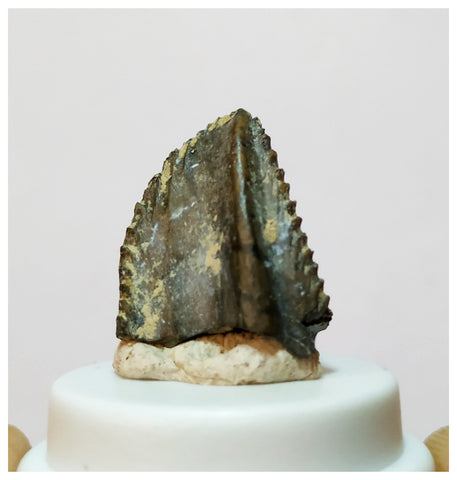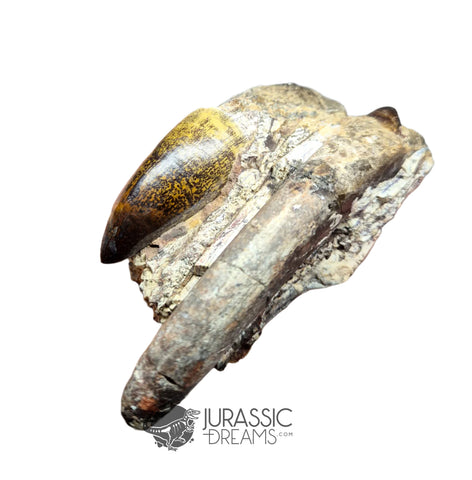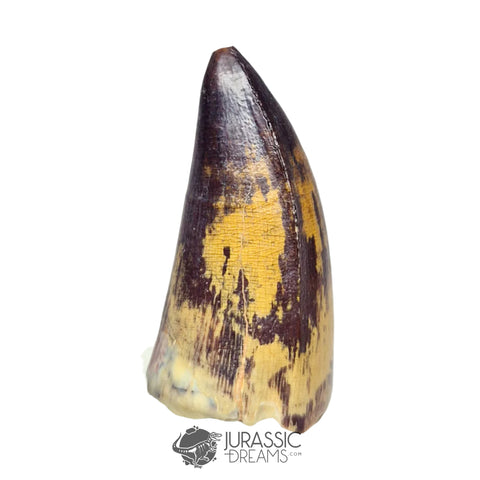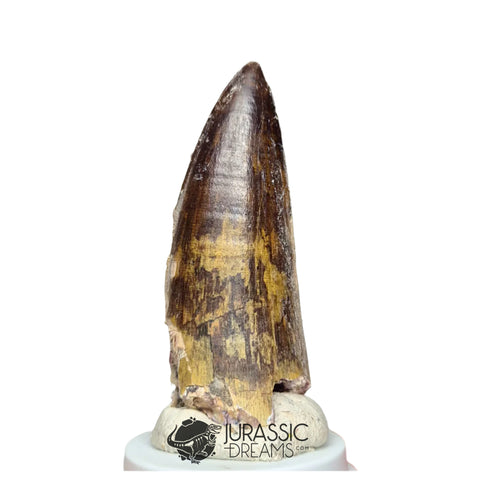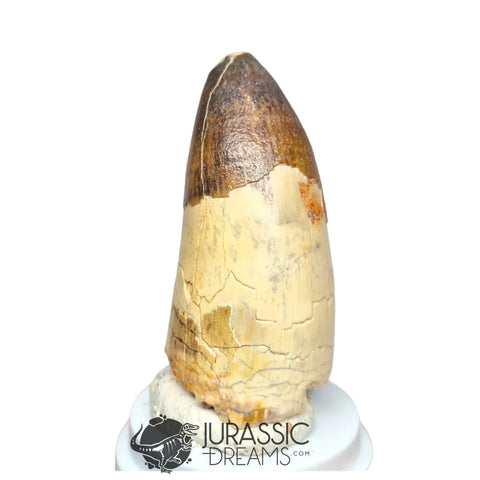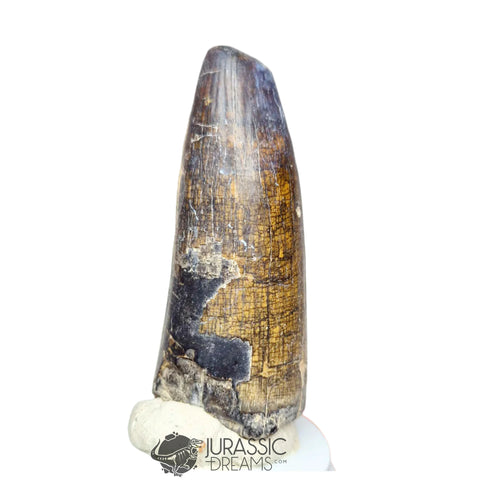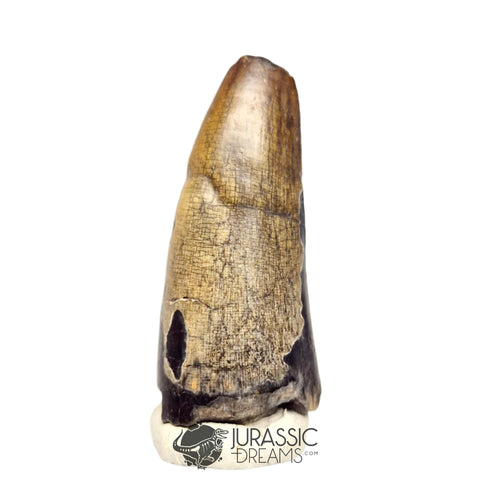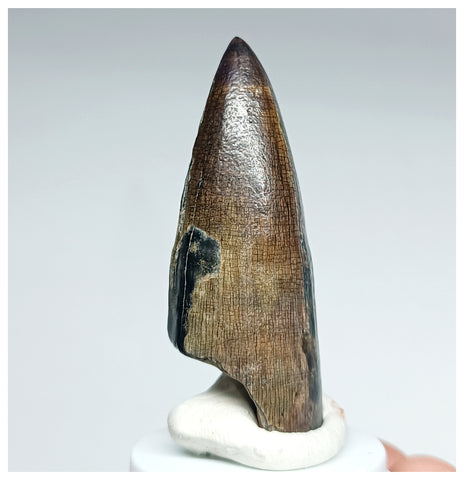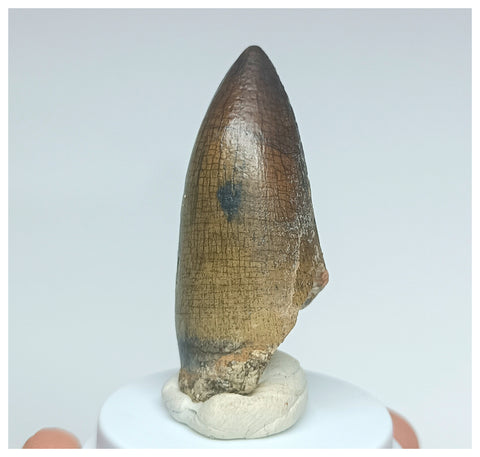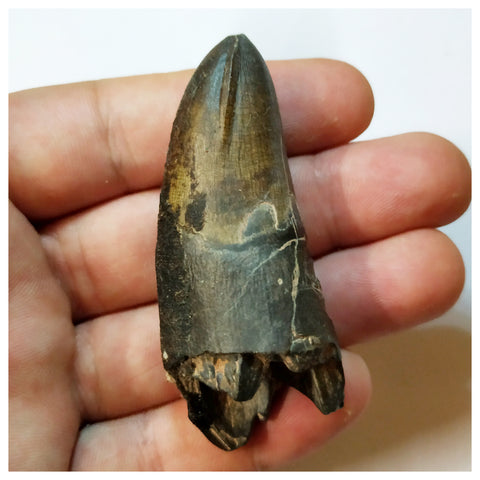This enormous Prognathodon tooth is preserved in exceptional way. It does not have any restoration or reparation. The size corresponds without doubt to an adult individual. The tip of the tooth is perfectly preserved and tremendously pointed. The quality of the enamel is very high due to the beautiful range of caramel brilliant hues. It does not have any product or treatment that has altered its original shine and color.
In the international market is very common to find Mosasaurus rests coming from the phosphate quarries of the Upper Cretaceous of the Ouled Abdoun Basin (Morocco).
This quarries have been exploited since the beginning of the past century. Many sellers that sell this fossils do not make a good precise taxonomic identification work.
In these sites there are numerous different species of Mosasaurus described in the enormous assemblage of giant marine reptiles that reigned the seas during the Cretaceous.
The main rich levels in these paleontological taxons are in the deeper stratigraphic levels of the sedimentarian filling of the Ouled Abdoun Basin. The age of these correspond to the Maastrichtian stage, 66 million years ago.
Most of the research carried out on these marine reptiles from Morocco have been performed by French researchers.
Next we list the different Mosasaur species which have been recognised in the phosphate rocks in North Africa:
-Halisaurus aramborgi (Bardet et al., 2005)
-Halisaurus walkeri (Lingham-Solier, 1998)
-Prognathodon sp (Dollo, 1889)
-Prognathodon anceps (Leiodon anceps)
-Prognathodon solvay (Dollo, 1889)
-Prognathodon currii (Christiansen & Bonde, 2002)
-Eremiasaurus heterodontus (LeBlanc et al., 2012)
-Mosasaurus beaugei (Arambourg, 1952)
-Mosasaurus hoffmanni (Mantell, 1829)
-Tylosaurus (Marsh, 1872)
-Platecarpus ptychodon (Arambourg, 1954)
-Globidens phosphaticus (Bardet et al., 2005)
-Carinodens belgicus (Bardet et al., 2005)
The Ouled Abdoun Basin (or Khouribga Basin), located in the central sector of Morocco, is an enormous sedimentarian basin represented mostly by a vast filling of phosphate sediments. Apart from having a relevant raw material to be extracted, it has a series of very important paleontological sites in which amazing assemblages from big and small marine vertebrates are present. The basin has a so great continuity in its stratigraphic record that both the Upper Cretaceous as well as the two first epochs of the Paleogene (Paleocene and Eocene) can be studied.
The main assemblage of vertebrate fossils of the Paleogene sector present there is composed by sharks, fish, turtles, marine snakes, rays, crocodiles, other types of reptiles and even marine birds. In the Cretaceous part we can add Mosasaurs, Pterosaurs and Plesiosaurs.
Next you can visit a link with very interesting information about this sedimentarian basin rich in fossil vertebrates: Ouled Abdoun Basin
Prognathodon Anceps
SYSTEMATIC PALEONTOLOGY
Order SQUAMATA Oppell, 1811
Family MOSASAURIDAE Gervais, 1853
Subfamily MOSASAURINAE Williston, 1897
Genus PROGNATHODON Dollo, 1889
All these teeth have subequal buccal and lingual surfaces (with buccal surfaces slightly more inflated), sharp and excavated cutting edges,weakly developed facets and more or less clearly developed beading of the enamel.The last feature makes a significant difference in relation to teeth of the genus Liodon Agassiz,1846(= Leiodon . Owen,1841,non Swainson,1839),which are smooth,including the type material of Leiodon anceps Owen, 1845 from the Upper Campanian Belemnitella mucronata Zone of Essex, England (Lingham−Soliar1993).
The material described by Arambourg (1952) is in need of revision; it may represent a new mosasaurid taxon.
Awaiting this revision, we provisionally denote the Polish and Maastricht specimens as “ Mosasaurus ( Leiodon ) cfr.anceps
https://nmgs.nmt.edu/publications/guidebooks/downloads/56/56_p0389_p0393.pdf
http://www.academia.edu/388824
/A_new_species_of_Prognathodon_Squamata_Mosasauridae_from_the_Maastrichtian_of_Angola_and_the_affinities_of_the_mosasaur_genus_Liodon
http://www.tandfonline.com/doi/abs/10.1080/02724634.2011.601714#preview
http://en.wikipedia.org/wiki/Mosasaurus
https://www.app.pan.pl/article/item/app48-397.html
Publications:
Baird, Donald (1986): Halisaurus and Prognathodon, two uncommon Mosasaurs from the Upper Cretaceous of New Jersey. In: The Mosasaur, Vol. 3, S. 37–45.
Bardet et al. (2012) A skull fragment of the mosasaurid Prognathodon cf. sectorius from the Late Cretaceous of Navarre (Basque-Cantabrian Region). Bull. Soc. géol. France, 2012, t. 183, no 2, pp. 117-121.
Buchy, Marie-Céline; Frey, Eberhard; Wolfgang Stinnesbeck & José Guadalupe López-Oliva (2007): Cranial anatomy of a Maastrichtian (Upper Cretaceous) mosasaur (Squamata, Mosasauridae) from north-east Mexico. In: Revista Mexicana de Ciencas Geológicas Vol. 24, N. 1, S. 89–103.
Buffetaut & Bardet (2012) The mosasaurid (Squamata) Prognathodon in the Maastrichtian (Late Cretaceous) of the Cotentin Peninsula (Normandy, northwestern France). Bull. Soc. géol. France, 2012, t. 183, no 2, pp. 111-115.
Christiansen, Per &. Niels Bonde (2002): A new species of gigantic mosasaur from the Late Cretaceous of Israel. In: Journal of Vertebrate Paleontology 22 (3), S. 629-644.
Dortangs, Rudi W.; Schulp, A.; Mulder, E.; Jagt, J. W. M.; H. Peeters & D. de Graaf (2002): A large new mosasaur from the Upper Cretaceous of the Netherlands. In: Geologie en Mijnbouw, 81(1), S. 1-8.
Grigoriev (2013) Redescription of Prognathodon lutugini (Squamata, Mosasauridae). Proceedings of the Zoological Institute RAS, Vol. 317, No. 3, 2013, рр. 246–261
Kass, Michael S. (1999): Prognathodon stadtmanni: (Mosasauridae) a new species from the Mancos Shale (Lower Campanian) of Western Colorado. In: Vertebrate Paleontology in Utah, S. 275–294.
Campanian and Maastrichtian mosasaurid reptiles from central Poland Marcin Machalski, John W.M. Jagt, Rudi W. Dortangs, Eric W.A. Mulder, and Andrzej Radwański . Acta Palaeontologica Polonica 48 (3), 2003: 397-408
Konishi, T., D. Brinkman, J. A. Massare & M. W. Caldwell (2011) New exceptional specimens of Prognathodon overtoni (Squamata, Mosasauridae) from the upper Campanian of Alberta, Canada, and the systematics and ecology of the genus. In: Journal of Vertebrate Paleontology 31(5), S. 1026-1046.
Lindgren & Schulp (2010) New material of Prognathodon (Squamata: Mosasauridae), and the mosasaur assemblage of the Maastrichtian of California, U.S.A. Journal of Vertebrate Paleontology 30(5):1632-1636.
Lingham-Soliar, Theagarten &. Dirk Nolf (1989): The mosasaur Prognathodon (Reptilia, Mosasauridae) from the Upper Cretaceous of Belgium. In: Bulletin de l'Institut Royal des Sciences Naturelles de Belgique, Sciences de la Terre 59, S. 137-190.
Lucas, Spencer G.; Ikejiri, Takehito; Maisch, Heather; Thomas Joyce & Gary L. Gianniny (2005): The mosasaur Prognathodon from the Upper Cretaceous Lewis Shale near Durango, Colorado and the distribution of Prognathodon in North America. In: 56th Field Conference Guidebook, Geology of the Chama Basin, S. 389–394.
Russell, D. A. 1967. Systematics and morphology of American mosasaurs (Reptilia, Sauria). Peabody Museum of Natural History, Yale University, Bulletin 23:1–241.
Schulp, Anne S.; Michael J. Polcyn; Octávio Mateus; Louis L. Jacobs & Maria Luísa Morais (2008): A new species of Prognathodon (Squamata, Mosasauridae) from the Maastrichtian of Angola, and the affinities of the mosasaur genus Liodon. In: Proceedings of the Second Mosasaur Meeting, S. 1–12.










